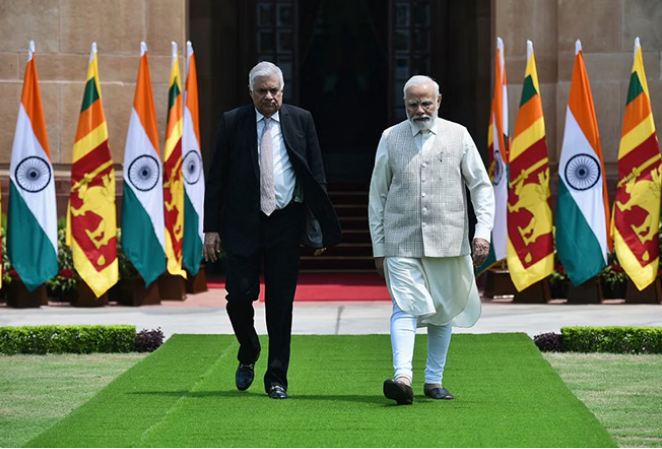There was a time when Sri Lanka was viewed as a neighbour of India that was rapidly moving out of New Delhi’s orbit. Despite protestations to the contrary by Sri Lankan policymakers, it was quite evident that the tilt in favour of China was getting more pronounced with Chinese money pouring in to give a semblance of dynamism to the island nation’s economy. Political elites in Sri Lanka would regularly highlight Indian inability to rise up to the challenge and would often point to Beijing’s hyper efficient ability to implement projects on the ground. If at all, India was a distant second to China’s predominance.
Last week’s visit by Sri Lankan President Ranil Wickremesinghe to India—his first visit abroad since taking over the nation’s leadership last year—stands as a testament to the remarkable turnaround in Delhi–Colombo ties in just a year’s time. During the visit, the two nations announced an economic-partnership vision that underscores India’s commitment to ensure a prosperous Sri Lanka as key to regional stability. It aims to strengthen connectivity—maritime, air, energy and people-to-people—between the two neighbours so that mutual cooperation can be further enhanced in various sectors, such as tourism, power, trade, higher education and skill development. Specific projects announced included passenger ferry services between Nagapattinam in Tamil Nadu and Kankesanthurai in Sri Lanka; a feasibility study on establishing a petroleum pipeline; a land bridge across the Palk Strait and the launch of the Unified Payments Interface in Sri Lanka.
Reiterating Sri Lanka’s important place in India’s ‘neighborhood-first’ policy, Prime Minister Narendra Modi underlined India’s belief that “the security interests and development of India and Sri Lanka are intertwined”. Wickremesinghe, for his part, saw his visit reinforcing “trust and confidence for our future prosperity in the modern world”. This bonhomie was underpinned by the critical role New Delhi has played in helping Colombo through one of the most serious crises in its post-independence history.
As the Sri Lankan economy went into a tailspin last year, it was India’s crucial support that helped the island nation in managing an explosive situation. At a time when key actors both domestically and globally were running away from confronting the challenge, New Delhi rose to the challenge. Gotabaya Rajapaksha, whose policies were primarily responsible for the crisis, fled the country and China who was bullish on Sri Lanka before the crisis was nowhere to be found once the crisis erupted on the streets. India not only provided around $4 billion in assistance to Colombo to tide over the precarious economic situation, it also took the lead in supporting the restructuring of Sri Lankan debt to the International Monetary Fund. India also helped Sri Lanka in tiding over the food, fertiliser and fuel crisis. As Modi mentioned in his remarks last week, “being a close friend, as always, we [Indians] stand shoulder-to-shoulder with the people of Sri Lanka”.
China, on the other hand, has been an integral part of the saga of gross economic mismanagement in Sri Lanka. Colombo had to suspend its foreign debt payments, largely because of its inability to service loans from China that were used to finance massive, but rather useless, infrastructure projects. China used its friendship with former President Mahinda Rajapaksa to sign an agreement to construct the Hambantota port and build the airport next door in Mattala—both in his constituency. Mahinda’s successor, Maithripala Sirisena, came to office wanting to reduce Sri Lanka’s dependence on China but ended up awarding the Hambantota port to China not only for a 99-year lease but also with a provision for extension for another 99 years.
Sri Lanka ended up owing $7 billion to China, emerging as a textbook example of China’s debt trap diplomacy today. While China agreed to strengthen Sri Lanka’s foreign currency reserves by swapping the Lankan rupee for its currency, the renminbi, it remained reluctant to move forward after the International Monetary Fund came into the picture and took a rather hands-off approach towards the Sri Lankan crisis. Only when it realised that it was getting isolated as India, Japan and other nations moved forward with their help, did it change course.
Despite China’s lackadaisical attitude towards Sri Lanka during the crisis, Colombo will continue to balance its ties between Beijing and New Delhi. Just last month, Sri Lankan foreign minister was in China where the two nations decided to work towards “high-quality Belt and Road cooperation” and underlined that Colombo will remain neutral in the Sino-Indian tensions. This is to be expected from a nation trying to juggle two major powers in its neighborhood.
But New Delhi will seek to ensure that its interests, be it pertaining to the implementation of the 13th Amendment or respect for India’s strategic red lines are kept in mind by Sri Lankan decision-makers as they manage a volatile geostrategic environment. By all accounts, President Wickremesinghe seems to have succeeded in conveying his nation’s best intentions for India during his visit. Whether those intentions can survive the onslaught of Chinese economic and diplomatic muscle in the coming days remains to be seen.









































